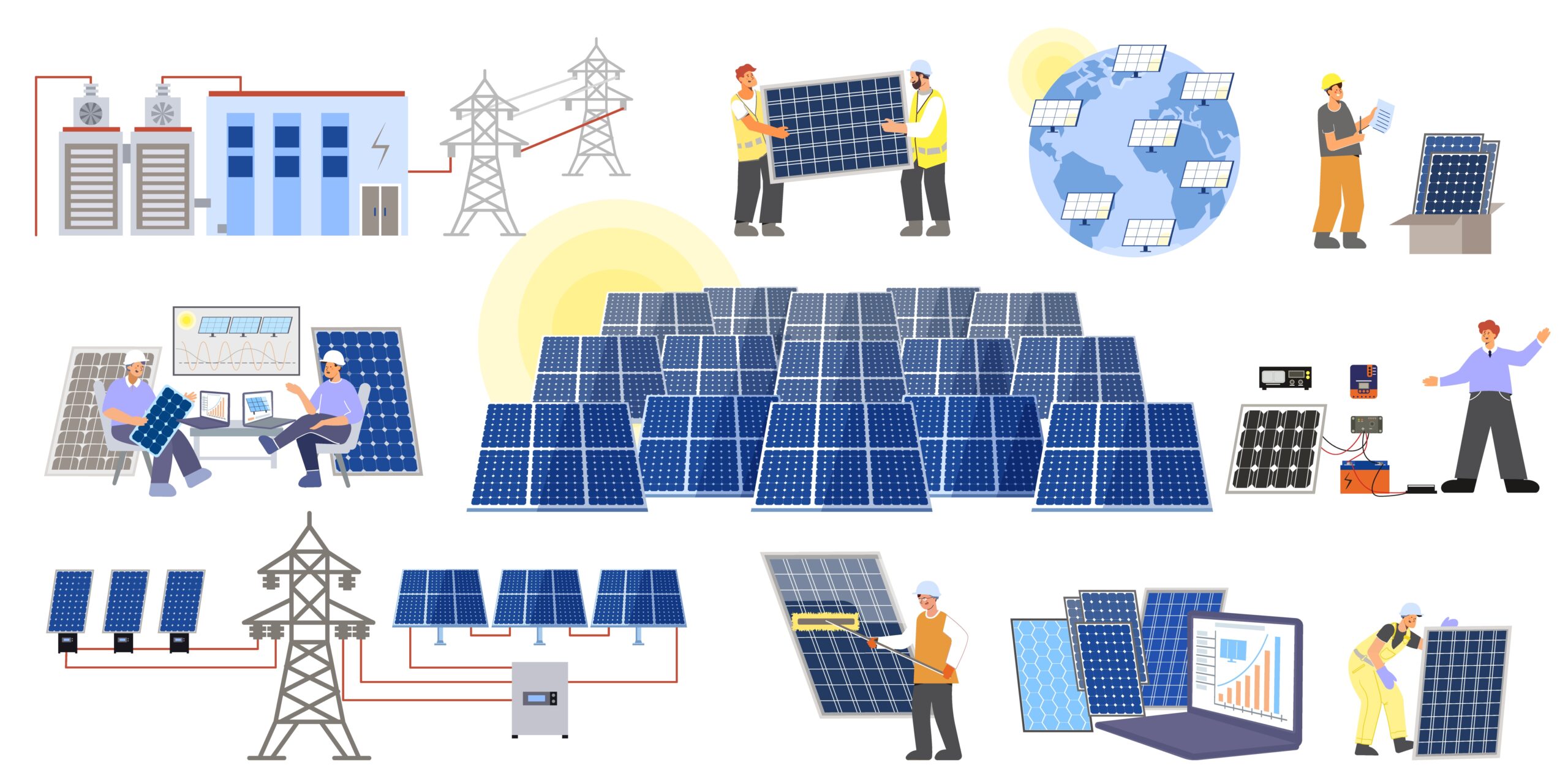In the quest for sustainable and clean energy solutions, scientists and engineers have been tirelessly working to harness the power of the sun. One groundbreaking innovation in the field of solar energy is Blue Energy Solar. Combining the principles of photovoltaic and thermal solar technologies, Energy Solar presents an exciting approach that holds tremendous potential for revolutionizing renewable energy. In this article, we will explore the concept of Energy Solar, its benefits, and its role in paving the way toward a greener future.
Understanding Blue Energy Solar:
Blue Energy Solar, also known as hybrid solar energy, merges two distinct technologies: photovoltaic (PV) and solar thermal (ST) systems. By combining the advantages of both, Blue Power Solar maximizes energy production and efficiency.
The PV system in Blue Solar converts sunlight directly into electricity using semiconductors, such as silicon cells. These cells capture the sun’s photons and generate an electric current. Meanwhile, the ST system utilizes mirrors or lenses to concentrate solar radiation onto a fluid, which heats up and generates steam to power turbines for electricity generation.
Benefits of Blue Energy Solar:

- Increased Energy Output: The integration of PV and ST systems in Blue Energy Solar significantly boosts energy production. While PV systems convert only a portion of sunlight into electricity, the remaining solar energy is captured and used by the ST system for thermal power generation. This simultaneous utilization of solar radiation enhances overall energy output.
- Enhanced Efficiency: Blue Solar offers higher system efficiency compared to standalone PV or ST systems. The combination of two technologies maximizes the utilization of available sunlight, resulting in increased energy conversion and improved overall efficiency.
- Round-the-Clock Power Generation: Traditional solar systems rely on daylight to generate electricity. Blue Solar, however, has the potential to generate power round-the-clock. The ST system captures and stores thermal energy during the day, which can be utilized during periods of low or no sunlight. This feature enables continuous power generation, even during nighttime or cloudy conditions.
- Utilization of Wasted Heat: One notable advantage of Solar is its ability to utilize the wasted heat generated by PV systems. In conventional PV systems, excess heat is dissipated, resulting in energy loss. By integrating ST technology, Blue Energy Solar captures this excess heat and converts it into useful energy, further improving overall system efficiency.
- Environmental Sustainability: Solar contributes to a cleaner and greener future by reducing greenhouse gas emissions. By relying on renewable energy sources, this technology helps mitigate climate change and reduce dependence on fossil fuels.
The Role of Solar in a Greener Future:
Blue Energy Solar has the potential to play a significant role in the global transition to sustainable energy systems. Its benefits make it a promising contender for widespread adoption and implementation. Here’s how Blue Energy Solar can contribute to a greener future:
- Powering Residential and Commercial Buildings: Blue Energy Solar can be integrated into buildings, both residential and commercial, to provide clean and sustainable electricity. By generating power on-site, these buildings can reduce their carbon footprint and dependence on conventional energy sources.
- Electricity Generation in Remote Areas: Blue Energy Solar can be deployed in remote and off-grid areas where access to conventional power sources is limited. The ability to generate electricity round-the-clock ensures a reliable power supply, improving the living conditions of these communities and enabling socio-economic development.
- Industrial Applications: Blue Energy Solar’s efficient energy generation and utilization make it an ideal choice for various industrial processes, such as desalination, chemical production, and manufacturing. By harnessing the power of the sun, industries can reduce their reliance on fossil fuels and minimize their environmental impact.
- Integration with Existing Energy Infrastructure: Blue Energy Solar can be seamlessly integrated into existing energy infrastructure, including power grids. This integration allows for a smoother transition to renewable energy while providing a stable and sustainable electricity supply to meet growing demand.
Expanding the Applications of Energy Solar:
- Sustainable Agriculture: Blue Energy Solar can revolutionize the agricultural sector by providing renewable energy for irrigation systems, greenhouse operations, and farm machinery. By utilizing clean energy, farmers can reduce their carbon footprint and increase their operational efficiency, leading to sustainable agricultural practices.
- Water Heating and Cooling: Blue Power Solar can be employed for water heating and cooling applications in residential, commercial, and industrial settings. By utilizing the thermal energy captured by the ST system, it can be used to heat water for domestic use, swimming pools, or industrial processes that require heated water. Similarly, the cooling properties of Blue Energy Solar can be harnessed for air conditioning and refrigeration, reducing energy consumption and environmental impact.
Expanding the Applications of Solar:
- Sustainable Agriculture: Blue Solar can revolutionize the agricultural sector by providing renewable energy for irrigation systems, greenhouse operations, and farm machinery. By utilizing clean energy, farmers can reduce their carbon footprint and increase their operational efficiency, leading to sustainable agricultural practices.
- Water Heating and Cooling: Solar can be employed for water heating and cooling applications in residential, commercial, and industrial settings. By utilizing the thermal energy captured by the ST system, it can be used to heat water for domestic use, swimming pools, or industrial processes that require heated water. Similarly, the cooling properties of Blue Energy Solar can be harnessed for air conditioning and refrigeration, reducing energy consumption and environmental impact.
Advancements and Future Prospects of Solar:

- Technological Innovations: Ongoing research and development in Solar are focused on improving system efficiency, reducing costs, and enhancing durability. Innovations include the use of advanced materials, such as perovskite-based solar cells, and the integration of energy storage technologies, like batteries, to enable better energy management and grid integration.
- Large-Scale Deployment: Blue Energy Solar is gaining momentum globally, with pilot projects and large-scale deployments showcasing its potential. Governments and private entities are investing in the development of Solar farms and power plants to accelerate the transition toward renewable power.
- Power Storage Integration: The integration of power storage solutions, such as lithium-ion batteries, with Solar systems is crucial for maximizing its benefits. Storing excess electricity generated during peak sunlight hours enables its use during periods of low or no sunlight, ensuring a stable and reliable power supply.
- Policy Support and Incentives: Governments around the world are recognizing the significance of renewable power and are implementing favorable policies and incentives to promote the adoption of Solar. These measures include feed-in tariffs, tax credits, and subsidies, making it more economically viable for individuals and businesses to invest in this technology.
Conclusion:
Blue Power Solar represents a remarkable advancement in renewable energy technology, offering increased energy production, enhanced efficiency, and round-the-clock power generation. Its ability to utilize wasted heat and contribute to a greener future makes it a promising solution for our energy needs. As we strive towards a sustainable and clean energy landscape, Blue Energy Solar can play a vital role in paving the way toward a brighter future powered by the sun.
